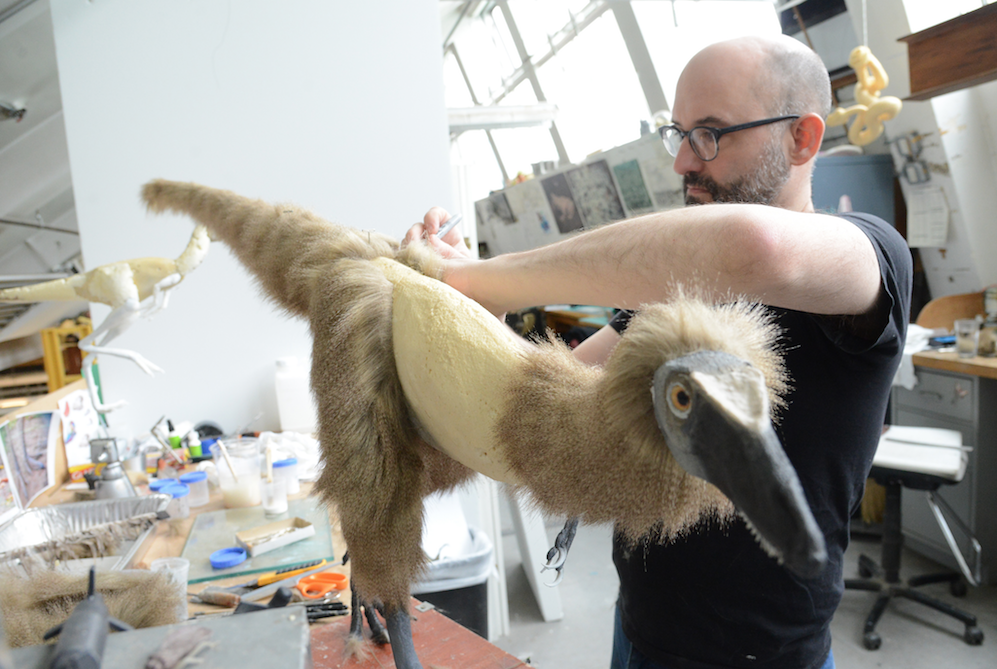Building the most accurate dinosaur
A museum illustrator creates art out of science.
Polina Porotsky • November 22, 2019

Jason works on a model of the tyrannosaur Dilong paradoxus for the American Museum of Natural History's T. rex: The Ultimate Predator exhibition, now open at the Museum. Credit: ©AMNH/R. Mickens
A four-foot tall, toothless head of a Tyrannosaurus Rex, arguably the world’s most famous dinosaur, was laying peacefully on the studio table at the American Museum of Natural History, New York’s own Hogwarts of science. The clay head was adorned with hundreds of scutes, bumps, and crevasses, making it the most accurate dinosaur model created to date. Jason Brougham, an illustrator and designer at the museum, stood beside it, looking, momentarily, content. He remarks on the soft, October rays of sun that stream through the Northern windows. They provide the kind of continuous illumination exalted by grand masters of the past.
“Reconstructing the past is a large part of my life,” Brougham says. One of his latest projects – an exhibit called “T.rex: The Ultimate Predator,” which opened in March – takes us back 100 million years ago. As visitors walk through the dimly lit pathway, combined with ambient sounds and happy squeals of children, following T.Rex’s maturation from a newly born to a 21 year old, 15-foot giant.
Brougham is in his late forties. His dark brown eyes, framed by thick glasses, look at things with intensity that betrays the mind of someone who studies things deeply and perhaps even obsessively.
He is dressed in a green shirt, blue jeans, and black Converse shoes, the kind of youthful, practical clothes one might see on a young graphic designer or a Silicon Valley engineer.
Brougham has been at the museum for 21 years, ever since he walked through its mighty halls on a December day of 1998 and into the studio in the northwestern block of the building. Longtime museum artist, Stephen Quinn, hired him on the spot.
“If I had known how great this job was, I would have blown it,” Brougham says of his interview with Quinn. “I would have been so nervous, maybe tried to game the system somehow. But instead I just fell backwards into it and it was perfect.”
For someone like Brougham, being a museum artist fulfills two passions at once: science and art. He grew up in suburban Detroit, in an artistic family. His father, a meticulous man, made clay car models for General Motors and was an avid birder, his mother studied art in college. One childhood story that in retrospect is indicative of Brougham’s own meticulousness is this one: When he was five years old Brougham asked his father to draw him a lobster. The next morning young Brougham sat at the desk, drawing and redrawing the image with tracing paper. But something was off. He just couldn’t get it right and, feeling defeated, cried.
During his undergraduate years at the University of Michigan, Brougham struggled to choose between a biology and an art major, but eventually decided on fine art. His inspiration came from Lucien Freud and Frank Auberbach and his own experiments in painting were supplemented by sculpture to allow him to paint in a more three-dimensional way.
But the transition between painting and scientific modelling was still a big change. Inside the halls of the museum, the majestic, albeit slightly worn, taxidermy displays are constrained by scientific facts.
“In art school somebody might sit for you and you paint a project,” Brougham says. “In this case we have to go to the scientific literature to find the information. Sometimes they can give us a real fossil, and we will keep it locked up in a cabinet and use it for reference.”
Looking at the towering body of T.Rex, it is hard to imagine that dinosaurs that now attract more than 5 million people to the museum, actually inhabited the planet 83 million years ago, yet their models are not products of the artists’ imagination. Before beginning any new model Brougham and his colleagues work to understand the new scientific literature. He also equips himself with hundreds of reference images of ostriches and other flightless birds; these almost imperceptible details will end up making the model believable.
Inevitably, everything in science shifts and moves, and so do the models. Take, for instance, the microraptor. Brougham first recreated the dinosaur back in 2005 when the color of the skin was simply assumed to be brown because it’s a color typical for birds living in temperate climates. Fast forward eight or nine years, he says, and scientists are able to use structures preserved in feathers called melanosomes to reverse engineer the color. By the time the third model was made, the dinosaur became an iridescent black. Even more surprising might be the fact that the latest dinosaur models have feathers – newly uncovered evidence suggests that dinosaurs were much fluffier than previously thought.
“I feel very satisfied because I can rectify some of our mistakes,” he says.
Those far away from paleontology might be perplexed by the pursuit of accuracy in historical details from millions of years ago, but Brougham sees a larger picture. To him, the time continuously shrinks and expands between the present and the past and reconstructing images from 100 million years ago suddenly does not seem that different from reconstructing the history from four years ago.
“You could say the Mueller Report was a reconstruction. It took years to figure out what happened in 2016, right? Even for events in our regular lives, it takes time to figure out, in retrospect, what everyone’s motivations and priorities were.”